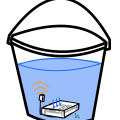News J-WAFS researchers seek to better understand water access in rural India
Jonathan Bessette and Gokul Sampath have been awarded a J-WAFS India Grant to conduct research on safe water access in Indian villages through sensor-enabled data collection.
Carolyn Blais, J-WAFS December 13, 2023

In August of 2022, Gokul Sampath and Jonathan Bessette, two MIT PhD students, got to know each other personally and professionally while attending World Water Week. The two traveled to Stockholm, Sweden for the annual international water conference, where they were part of a cohort of four 2022 J-WAFS Travel Grantees. The Travel Grants allow outstanding MIT graduate students with research in the water sector to attend select water conferences for academic and professional development. The students act as J-WAFS representatives while attending seminars, panel discussions, and networking events.
“Prior to being brought together for World Water Week I did not know Jonathan” says Sampath. “We have so many overlapping interests around water and international development…I am certain that this shared experience at World Water Week will lead to future research collaborations,” Sampath noted in his recap of the experience back in 2022.
As predicted, Sampath and Bessette have joined forces on a new research project. Expanding on the ideas they discussed during World Water Week, the two MIT PhD students have combined their expertise to address the global data gap on water fetching practices in places like rural India through a novel sensor-based approach.
Today, J-WAFS is happy to announce that Sampath and Bessette’s project has received a 2023 J-WAFS Grant for Water and Food Projects in India. The funding opportunity is for current members of the MIT community interested in addressing a water or food-related challenge in India. The grants are intended to further work being pursued by individuals as part of their MIT research, innovation and entrepreneurship, coursework, or related activities. The expectation is that projects will benefit low-income populations, and they typically involve on-the-ground work in local communities in India.
“After pausing the India Grant due to suspended travel during the pandemic, we are excited to relaunch the grant with this promising project,” said Renee J. Robins, J-WAFS executive director. “We were excited to learn that it grew out of a prior opportunity that we supported. We look forward to a successful collaboration between the team and J-WAFS,” Robins added.
Sensor-enabled devices to fill the water fetching data gap
Since the discovery of arsenic in wells in Eastern India in the late 1980s, governments and nongovernmental organizations have sought to address the problem in rural villages by providing safe community water sources. Yet despite access to safe alternatives, many households still fetch and consume water from contaminated wells. As a result, approximately 40 million people across the region are at elevated risk of cancer, stroke, and heart disease from arsenic present in drinking water and cooked food. Women are the primary water fetchers for most families in rural India, but the scarcity of data on exactly how women choose water sources makes it difficult to develop strategies to reduce arsenic exposure.
Automated data collection of water fetching practices in the developing world could offer a cheap and accurate way to gather data with greater geographic scope and breadth. Bessette and Sampath are developing small sensors to be placed inside water fetching vessels to make “smart buckets” that can help obtain a clearer picture of fetching practices in arsenic affected villages. By demonstrating the efficacy of a sensor-based approach to understanding water fetching practices, the researchers hope to address a major data gap in international development.
Plans for the sensors include the collection of data on the water sources households chose, the quantity of water fetched, the distance fetchers travel, and the time they spend waiting to fill their buckets. The sensors are already under development as part of an MIT project-based undergraduate course in the Department of Mechanical Engineering, called Global Engineering. The course is taught by Professor Amos Winter, who is a prior recipient of J-WAFS seed grants. Bessette, a mechanical engineering doctoral student in Winter’s lab, is leading the undergraduate team to design, integrate, assemble, test, and calibrate a prototype of the sensor by the end of the semester.
With the J-WAFS funding, the team plans to pilot 400 of the sensors in 200 households across four arsenic-affected villages in rural West Bengal, India: Gehapur, Tunpura, Ghola, and Chandrapur. The three-month long trial will be undertaken within a larger longitudinal diary study on water fetching decisions and the social determinants of arsenic exposure. The team is collaborating with an organization called Water for People to assist with implementation of the trial. Sampath, a doctoral student in MIT’s Department of Urban Studies and Planning, will lead the diary study, conduct the training of local surveyors, and manage the installation and distribution of sensors to the households. Sampath and Bessette will validate the robustness of the sensor architecture to real-world conditions and compare the results of the sensor-enabled devices to the longitudinal water diary study.
At the end of the field trial, households who participated will be able to offer feedback as to how the sensor modules might be improved for greater ease in the water collection process. Later, all water sources used by households will be tested for arsenic, and additional follow-up will be conducted to ensure due diligence in informing communities of the health threats they face.
“We are both looking forward to this collaboration” Sampath says. “Ultimately, we hope this project will allow practitioners to better understand previously unknown facets of water fetching and monitoring.”
